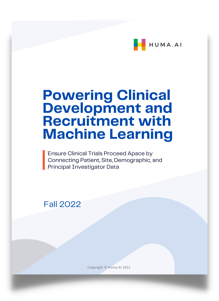Can Machines Understand Cause and Effect?
In the simplest terms, machine learning (ML) is based on the ability of algorithms to learn from data.
To make predictions, machine learning algorithms must first be trained on data sets containing known outcomes. The more data the algorithm has to work with, the better it can learn and make predictions. Once an algorithm has been trained, it can then be applied to new data sets to predict future outcomes.

Machine learning methods have traditionally been used for pattern recognition and prediction rather than causal inference (i.e., understanding cause and effect). The ability of machine learning to predict patterns is valuable in itself, but using machine learning specifically to make causal inferences is still evolving.
According to the journal Value in Health, “Machine learning can be used for hypothesis generation, followed by the application of traditional causal methods. But relatively recent developments, such as targeted maximum likelihood methods, are directly integrating machine learning with causal inference.”
Understanding causality would allow us not just to predict but also to create business models that solve business problems.
The Difference Between Humans and Machines
Humans often think in terms of cause and effect. Understanding what causes something to happen enables us to change our behavior so that a different result happens. In other words, we try to learn causality from data.
For instance, if we can figure out why a specific outcome happened, we can change our behavior so that another outcome results, which means we can change the result if we change our behavior.
Understanding cause and effect would make AI systems smarter. For example, if a robot understands that dropping things will cause them to break, it won’t need to toss dozens of vases onto the floor to see what happens to them. Instead, it can learn that the vases break when the robot drops them. While the ability to understand correlations can be useful, the ability to understand causality is far more powerful.
According to Royal Science Journal: “Causal machine learning (CML) has experienced increasing popularity in healthcare. Beyond the inherent capabilities of adding domain knowledge into learning systems, CML provides a complete toolset for investigating how a system would react to an intervention (e.g., outcome given a treatment). Quantifying effects of interventions allows actionable decisions to be made while maintaining robustness in the presence of confounders.”
Newer causal inference methods are being developed which directly integrate machine learning with causal inference.
The Growing Demand for Real-World Evidence
As the demand for real-world evidence grows, so does the need for new and innovative ways to collect and analyze data.
Machine learning is one of the most promising tools for meeting this demand. Machine learning algorithms can automatically detect patterns in data, which can then be used to predict future events. This makes them well suited for observational studies, where data is often collected retrospectively. In addition, machine learning algorithms can be used to control for confounding factors that may bias results.
Over time, the accuracy of predictions made by machine learning algorithms has continued to improve.
This is partly due to advances in the underlying technology and increased computing power but also because researchers have gained a better understanding of how to optimize these algorithms for specific applications.
According to the journal Neurospine, “Electronic medical records are a key source of medical data that can be leveraged for the creation of clinically valuable machine learning algorithms.’
By incorporating data from electronic health records, medical imaging scans, laboratory tests, and other sources, these models can better understand the complex interactions between different factors that influence disease progression and recovery. As a result, they can make more accurate predictions about patient outcomes than traditional statistical methods alone.
It is clear that machine learning offers immense potential for improving our ability to collect and analyze data to make evidence-based decisions about everything from individual healthcare treatments to public policy programs.
Other Applications of ML
There are many potential applications of machine learning in real-world evidence research.
One area where machine learning could be particularly useful is in the identification of patient subgroups. Traditional methods of subgroup identification, such as latent class analysis, require a large amount of expert knowledge and are often limited by the size and complexity of the data. On the other hand, machine learning methods can automatically identify subgroups based on patterns in the data.
This could potentially lead to a better understanding of which treatments are most effective for which patients.
For example, researchers might apply machine learning techniques to a patient demographics, treatment history, and health outcomes dataset. Using these data, the algorithm could identify subgroups based on key characteristics such as treatment response or disease severity. By doing so, scientists could better understand which treatments may be more effective for certain groups of patients and which patients may be more likely to experience certain side effects or adverse events.
According to a 2021 article in Frontiers in Pharmacology, “In the past decade, the emergence of machine learning (ML) applications has led to significant advances towards implementation of personalized medicine approaches for improved health care, due to the exceptional performance of ML models when utilizing complex big data.”
The use of machine learning methods in real-world evidence research has the potential to significantly improve our understanding of how various treatments affect different patients.
Looking Ahead
The use of machine learning for causal inference is still in its early stages.
However, the potential applications are numerous and exciting. As more research is done in this area, machine learning will likely play an increasingly important role in real-world evidence research, helping to generate new hypotheses, detect subgroups and predict outcomes with greater accuracy and efficiency.
According to Trials, “ML holds great promise for improving the efficiency and quality of clinical research, but substantial barriers remain, the surmounting of which will require addressing significant gaps in evidence.”
Machine learning has tremendous potential to revolutionize real-world evidence research and improve our understanding of the complex relationships between treatment, disease, and patient outcomes. With continued investment in research and development, we can look forward to a future where machine learning plays a crucial role in driving better healthcare decisions and delivering better patient outcomes.
Understanding causality would allow us to not just predict but also create business models that solve business problems.
Want Deeper Clinical Trials Insights?
Finding the sites and principal investigators to conduct trials is no small task.
With Huma.AI , however, a single intelligence layer is placed over a wide variety of data sets pulled from almost any source.
Huma.AI uncovers deeply buried clinical trial insights that give clinical professionals the highly targeted intelligence and market advantage needed to create more successful trials.
Book a free demo to see how Huma.AI can boost your clinical intelligence.
.png?width=300&height=120&name=Huma-AI-Logo-(Horizontal).png)



.png?width=200&name=Huma-AI-Logo-(Horizontal-Reverse).png)